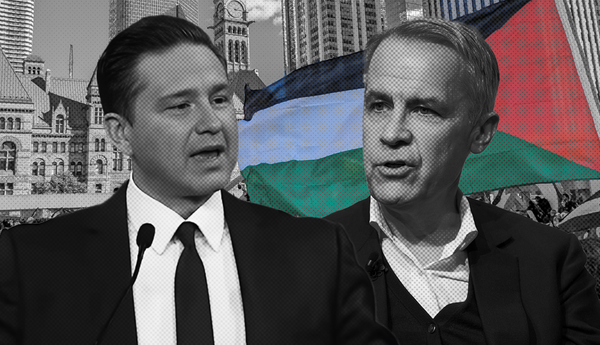On May 11, the British Columbia NDP held a press conference to announce they were introducing paid sick leave. Workers will be eligible for three days of paid, pandemic sick leave between June and December 31, with the promise of permanent sick days coming in 2022. Yet if you put this unclear promise for next year aside, you’ll notice that what the B.C. NDP are offering is remarkably similar to Ontario Premier Doug Ford’s Conservative government.
Ontarians are also entitled to three days of paid pandemic leave. Both governments are promising that employers can claim up to $200 per day from the government. And both governments introduced their measures this spring, more than a year after the pandemic began. There’s a couple of differences: Ontario’s program ends earlier, on September 25; B.C. promises that employees will be paid their full daily rate whereas Ontario caps the sick pay at $200 per day flat. If you work in a well-paid job but didn’t have sick pay prior to this announcement, you’re better off in B.C. than Ontario.
The criticisms of Ontario’s system — that big companies could exploit loopholes, that three sick days isn’t enough, that it doesn’t come close to what is offered elsewhere — are all valid, so you’d assume a self-identified progressive government with a recent electoral majority would try and do better. They haven’t.
That doesn’t just go for sick pay though. Throughout the entire pandemic, B.C. has projected an image of being sensible, striking a middle ground between the economy-first bluster of Alberta Premier Jason Kenney and Ford, and the COVID-Zero clampdown of the Atlantic bubble.
But that middle ground doesn’t exist. In trying to play both sides, the B.C. NDP has shown they come down on one: that of business. We’re just seeing capitalism with kinder rhetoric.
Lack Of Lockdowns
B.C. was the second province in Canada to detect a case of COVID-19. Yet it also had a relatively calm first wave, peaking at an average of 64.7 cases per day.
Bonnie Henry, the provincial health officer, was widely lauded by the public, receiving a glowing profile in the New York Times and a book deal recounting her experience of the first four weeks of the pandemic response. That book was announced in December 2020 (average daily cases: 591 and trending downward) and released in March 2021 (average daily cases: 595 and trending upward).
The NDP viewed the low case counts throughout the first wave as proof their plan, which involved asking people to make good choices while not actually mandating anything, would always work. B.C. never had a formal lockdown of non-essential businesses, but provincial and federal financing was in place to support widespread closures. (A friend worked non-stop for eight weeks running a coffee shop alone; it was the only coffee shop open in the neighbourhood, for good reason.)
It’s more likely that rather than being due to a good plan, however, B.C.’s spring was just a fluke. When the second wave arrived in the fall — with case counts and death numbers 10 times greater than the spring — the province seemed convinced they could do the same thing, and then seemed confused when these measures failed.
Meanwhile, other less progressive governments did a better job at introducing restrictions at various times. Ontario required that all students down to Grade 1 wear masks at school as of January 14; B.C. mandated masks for Grade 4 students and older on March 29.
Manitoba instituted a quarantine for inter-provincial travellers in January that coincided with a plateau in case counts, while B.C. Premier John Horgan dismissed the idea by saying the province had too many cross-provincial roads to enforce such a measure. (Manitoba has, arguably, more province-crossing roads than B.C.)
Quebec targeted regional hotspots with restrictions and curfews, which helped prevent a massive third wave. But B.C.’s laissez-faire attitude to new restrictions struggled to keep up with surging cases in specific areas; the whole province has been under the same orders since November, forcing both hotspot regions like Fraser Health and calmer regions like Island Health to adopt similar strategies.
Something B.C. did have in common with more conservative governments was a weird focus on personal responsibility. Kenney believed the “good judgement of Albertans” would slow the spread; Saskatchewan Premier Scott Moe said he had “faith in the good people of the province” to voluntarily obey restrictions; Horgan told people under 40 “don’t blow this for the rest of us.”
This emphasis on individual action over tougher measures dramatically misunderstands how the virus spreads. It places the blame on people who can’t do more, rather than politicians who won’t do more. Nothing more conservative than that.
Vaccines For The Old
B.C.’s vaccination strategy looks a lot like those in other provinces: prioritizing the elderly, having a gap of up to four months between first and second doses and slowly rolling down through age groups.
This approach is designed to minimize deaths, but it does so by ignoring the young, who are now more likely to catch and spread COVID-19 due to making up the bulk of the out-of-home work force. As such, it took a long time for vaccines to actually make a dent in case numbers.
One study from the University of British Columbia suggested that prioritizing essential workers older than 30 could help prevent tens of thousands of cases. Another study, from the University of California and Georgia State University, found that prioritizing vaccinating essential workers right after the most vulnerable was the best way to control spread.
B.C. did, of course, vaccinate essential healthcare workers as soon as they could. But considering B.C. didn’t shut non-essential shops at all, and kept restaurants, factories and construction sites open throughout the height of the third wave, anyone who works outside the home should have been considered an “essential worker.”
Instead, despite some regional vaccination occurring, B.C. mostly carried on with its age-based plan. Prioritizing out-of-home workers earlier could have helped prevent countless cases, hospitalizations and deaths. It took until May for grocery store workers to be able to get vaccinated.
Disabled people were also not adequately prioritized, with only limited medical conditions being considered serious enough for advance vaccination. Moreover, caretakers for disabled children repeatedly asked to be prioritized, only to be told condescendingly that ‘your time will come.’ This, again, was an area where more conservative provinces, such as Ontario and Alberta, course-corrected faster.
Workers whose jobs put them at a higher risk of contracting COVID-19 should have been vaccinated sooner. As it stands, B.C.’s system means a 25-year barista in a busy coffee shop, a 25-year-old parent to an immunocompromised child and a 25-year-old remote worker all became eligible for vaccination at the same time.
A left-leaning government is supposed to value workers over businesses. A government voted in by people who consider themselves progressive or socialist is expected to embody some of those values. How is anyone supposed to take the NDP seriously as a party for working people when they follow all the same playbooks as the right?
Data Opacity
One of the more curious aspects of B.C.’s sick pay legislation is the timing, as it was announced in the midst of a public row over the lack of data transparency.
On May 6, the Vancouver Sun published leaked reports from the B.C. Centre for Disease Control showing that the province had detailed, neighbourhood-based data on cases and positivity rates that wasn’t released to the public. The reports revealed, for example, that parts of Surrey had positivity rates of more than 20 per cent, which would have been useful to know for, say, parents trying to decide whether to send their children into school.
In a press conference held after the leaked reports were published, Henry claimed, “We are releasing more than what other provinces are reporting.” This is despite stories criticizing B.C.’s lack of public COVID-19 data as far back as at least October. The press conference also revealed that B.C. didn’t necessarily collect weekly community health service area data, but hoped to do so going forward (again, over a year into the pandemic.)
Responding to the issue, Brian Conway, medical director of the Vancouver Infectious Disease Centre, tweeted, “I am still concerned about the incomplete and irregular way in which data are being released. Knowledge would be so empowering and help us all be better parts of the solution.”
Data transparency is important practically, as it helps the public to make informed decisions. But it’s also important politically, to indicate that governments have nothing to hide. Having an ostensibly progressive provincial government also be the worst at sharing internal data is a bad look, precisely because we expect a higher level of accountability from them.
The timing of the sick pay announcement, therefore, looked a lot like a distraction. Ignore the fact we don’t share our data with the public. Instead, here’s a supposedly positive news story to focus on!
It’s easy to critique Ford and Kenney; of course those populist blowhards are going to make anti-science decisions at every turn. It’s more galling to realize the most ostensibly left-wing provincial government has acted almost exactly the same.
If this is the best the centre-left can do, we’re screwed.







